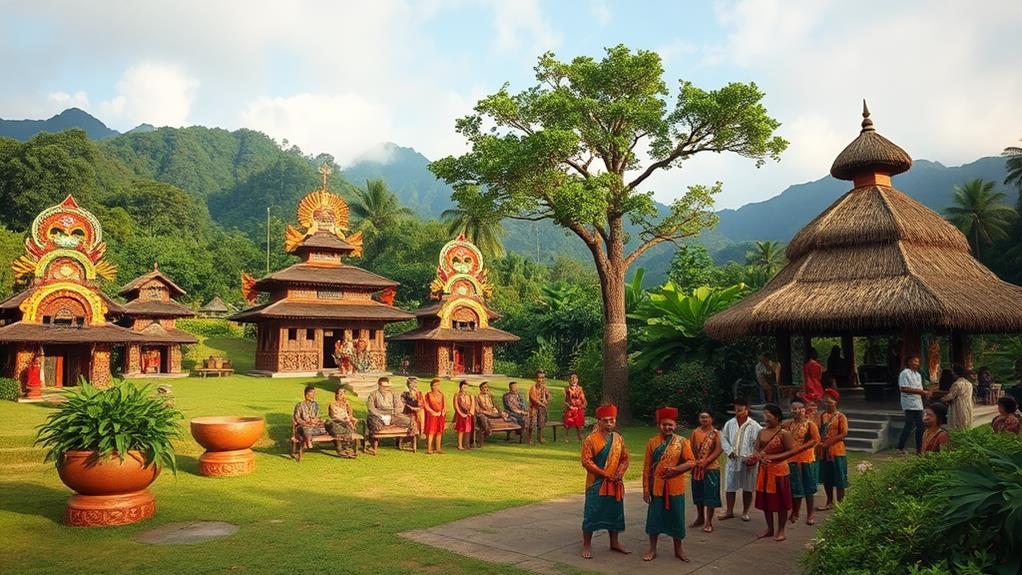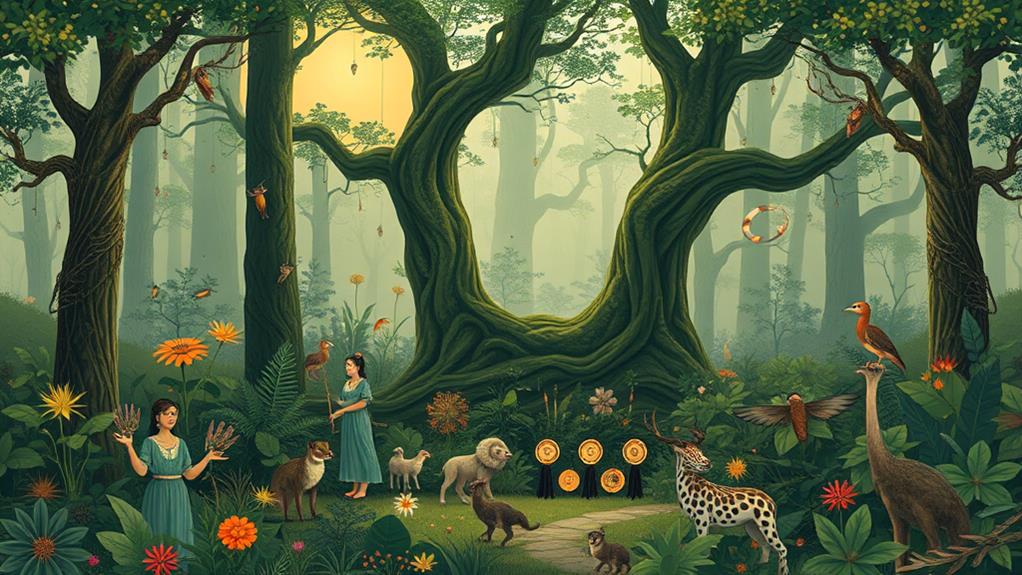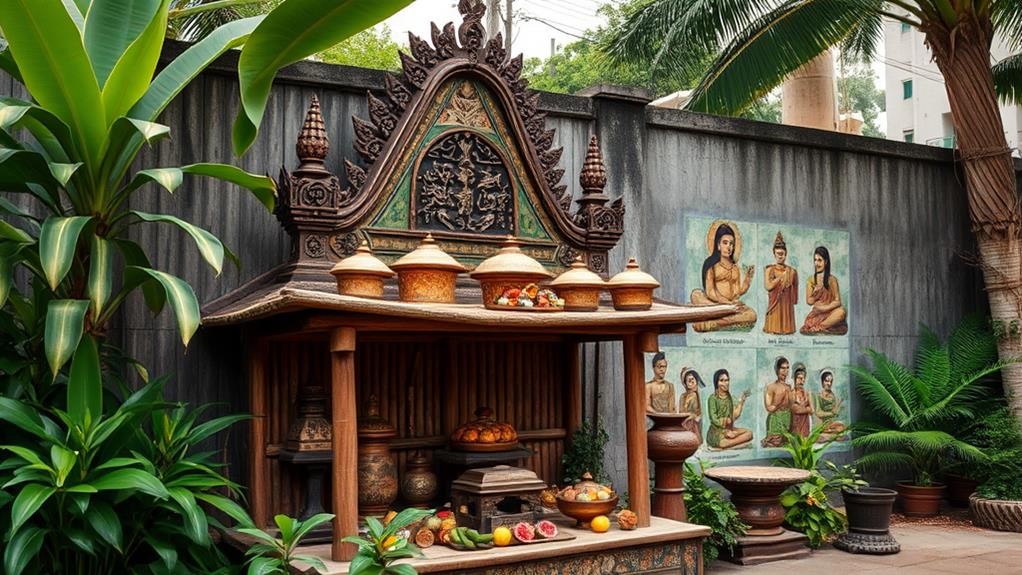Indigenous religions in the Philippines are rooted in a deep connection to the spirit world and nature. At their core is animism, which acknowledges the existence of ancestors (anito) and nature deities (diwata). These spiritual beings play a vital role in everyday life, influencing rituals and communal offerings that foster community bonds and honor these beliefs.
For instance, the Ifugao people of northern Luzon hold an annual festival, Hudhud ni Aliguyon, to honor their ancestors and deities.
Historical injustices and modern influences have threatened the preservation of these ancient beliefs. However, there is a growing interest in cultural expressions and educational initiatives that highlight the importance of preserving indigenous religions.
Contemporary representations in media, such as films and documentaries, offer a window into the lives of indigenous communities and their spiritual practices. These representations can provide valuable insights into how these rich traditions continue to endure today.
Overview of Indigenous Religions

Indigenous Religions in the Philippines
Indigenous religions in the Philippines make up about 0.23% of the population as of the 2020 census. These religions are primarily animistic, recognizing a parallel spirit world where ancestral spirits (anito) and nature deities (diwata) coexist with the material realm. Before Spanish colonization in 1521, nearly all pre-colonial Filipinos practiced these beliefs.
Rituals and Spiritual Leaders
Rituals like Pag-anito showcase the crucial role of spiritual leaders, or shamans, in invoking ancestor spirits for guidance and protection. These rites reflect the deep connection between community and spirituality. For example, in Pag-anito, shamans use rituals to communicate with ancestral spirits, seeking their guidance and protection for the community.
Impact of Colonization and Cultural Preservation
The arrival of Abrahamic religions during Spanish colonization led to significant declines in these practices. However, cultural preservation efforts have led to a slight increase in adherents from 0.19% in 2010.
Today, indigenous beliefs are often syncretized with Folk Catholicism and Folk Islam, highlighting the adaptability and resilience of these traditional practices in contemporary society.
Understanding Indigenous Religions
Understanding these indigenous religions reveals not just a spiritual framework, but also a cultural identity that continues to evolve. By exploring these beliefs and practices, we gain insight into the history, values, and traditions of the Filipino people.
Spiritual Beliefs and Practices
The Philippines' spiritual beliefs and practices are rooted in animism, where the material and spirit worlds blend together.
In this belief system, spirits known as anito and diwata inhabit both the natural and spiritual realms, significantly influencing daily life. These spirits are believed to reside in natural elements like trees, rocks, and animals, which are revered by indigenous groups.
Rituals like Pag-anito connect people with ancestor spirits. Shamans act as mediums, conducting ceremonies that involve communal feasts and offerings of food, rice, and even gold to seek guidance and protection.
Nature worship is a vital part of Filipino spirituality. Specific trees, rocks, and animals are considered sacred, highlighting the strong bond between ethnic groups and their environment. Offerings are made at sacred sites to honor the spirits residing in these elements, reinforcing this connection.
Ancestor worship is also integral to Filipino spirituality. Practices vary across groups, but offerings are made to ensure the guidance of ancestors in the afterlife.
Superstitions and divination practices are woven into daily life. Many people interpret natural signs and consult soothsayers to navigate life's challenges.
This spiritual worldview shapes cultural identity and guides decision-making, drawing on ancient traditions.
Role of Nature and Ancestors

Nature and Ancestors in Filipino Indigenous Religions
Nature's Active Role
In Filipino indigenous religions, nature isn't just a backdrop, but an active participant in the spiritual realm.
Every element is believed to possess a spirit, leading to a profound reverence for trees, rocks, and mountains, which are often seen as homes to diwata.
Ancestor Spirits
Ancestor spirits, or anito, serve as protectors and guides, with rituals like pag-anito inviting them to bless significant life events.
These ancestor spirits play a crucial role in the spiritual landscape of Filipino indigenous religions.
Vivid Aspects of Beliefs
Sacred sites like balete trees and burial caves embody the connection between the living and the spiritual realm.
These sites are believed to be inhabited by spirits and are often visited for rituals and ceremonies.
Offerings to the Spirits
Offerings of rice, meat, and fish are communal acts that honor the deceased and seek favor from the spirits.
These offerings are made to maintain a harmonious relationship between the community and the spiritual world.
Reincarnation Beliefs
Reincarnation beliefs emphasize that one's actions in life directly influence their soul's journey.
This belief encourages individuals to live a virtuous life, as their actions will have consequences in their future lives.
Balance and Harmony
By respecting nature and honoring ancestors through rituals and offerings, one helps maintain balance within the community and the spiritual world.
This balance is essential for the well-being of both the living and the spiritual realm.
Rituals and Community Involvement
Rituals Shape Community Bonds
In Filipino spiritual traditions, rituals play a crucial role in fostering deep connections among community members while bridging the living and ancestral spirits.
Community involvement is central to these practices, as shamans, often women, facilitate ceremonies that promote healing and guidance.
Rituals and Offerings
Pag-anito rituals involve offerings of rice, meat, and fish, which are placed in shrines made of bamboo.
Ati-Atihan Festival features spirit boats (taltalabong) as offerings, highlighting the unity of sacred and natural worlds.
Collective worship and ancestral spirit invocation involve communal feasts and traditional items, respectively.
Sacred Spaces and Community Participation
Natural materials are used to create sacred spaces for rituals.
Focal points for rituals, such as shrines and gathering places, serve as a testament to the resilience of cultures.
Community participation is essential in these rituals, ensuring the legacy of spiritual practices thrives within the community.
Festivals and Collective Identity
Ati-Atihan Festival exemplifies the unity of sacred and natural worlds, showcasing vibrant traditions that persist despite historical challenges.
These rituals not only honor ancestral spirits but also reinforce collective identity, ensuring the legacy of spiritual practices thrives within the community.
How does the concept of “Kapalaran” tie into the preservation of indigenous beliefs in the Philippines?
In Philippine beliefs, the concept of “kapalaran” holds a significant place in the preservation of indigenous traditions. Kapalaran in filipino beliefs refers to one’s destiny or fate, which is deeply rooted in the cultural and spiritual practices of indigenous communities. Embracing kapalaran helps to uphold and pass down age-old traditions, strengthening the preservation of indigenous beliefs in the Philippines.
Challenges to Cultural Preservation

Cultural Preservation in the Philippines: Challenges and Threats
The preservation of indigenous religions in the Philippines faces significant challenges, threatening their very survival. Only 2% of the population adheres to traditional beliefs today, a drastic decline from nearly 100% in 1521. Historical injustices, primarily stemming from Spanish colonization, have led to the marginalization and discrimination of indigenous peoples, hindering the transmission of their beliefs and practices.
Language Loss and Cultural Erosion
The loss of languages is a significant challenge to cultural preservation. Many indigenous languages are disappearing, erasing the words that hold cultural significance. For example, the Blaan language, spoken by the Blaan people of Mindanao, is considered endangered, with fewer than 100 fluent speakers remaining.
Threats to Rituals and Traditions
The fading of rituals and traditions is another challenge to cultural preservation. Foreign influences have replaced traditional practices, leading to a loss of cultural heritage. For instance, the traditional Ifugao rice terraces, a UNESCO World Heritage Site, are threatened by the introduction of modern farming practices.
Urgent Need for Action
The threat of extinction for ethnic religions is real, with predictions suggesting they could disappear by 2078. This emphasizes the need for urgent action to preserve indigenous cultures.
Constitutional guarantees for indigenous rights must be enforced, and initiatives like House Bill 4832, which promotes Moro history and culture, are crucial. These efforts serve as lifelines, safeguarding the heritage of the 14% of the population that still identifies with ethnic religions.
Modern Representations and Adaptations
Indigenous religions in the Philippines are experiencing a revival through modern representations. This resurgence is evident in various forms of media, where ancient beliefs are reimagined and reinvigorated.
Television shows like "Amaya" celebrate iconic figures like the diwata, a mythological being with supernatural powers. Similarly, video games like Warframe feature characters inspired by Philippine mythology, such as Titania, the queen of the faeries. These modern interpretations not only entertain but also educate audiences about the country's rich cultural heritage.
The first Filipino-developed role-playing game, "Anito: Defend a Land Enraged," immerses players in indigenous narratives, allowing them to connect with their cultural roots. This game is a prime example of how modern media can be used to preserve and promote cultural identity.
Festivals like Ati-Atihan showcase a blend of traditional and colonial influences, highlighting the resilience of the Filipino people in maintaining their cultural identity. The Aswang Project plays a crucial role in documenting Philippine folklore, ensuring that these stories remain relevant in contemporary discourse.
The following table summarizes key modern representations of indigenous religions in the Philippines:
| Representation | Medium | Significance |
|---|---|---|
| Diwata in "Amaya" | Television Series | Revives folklore |
| Titania in Warframe | Video Game | Engages with mythology |
| "Anito" RPG | Role-Playing Game | Interactive cultural narratives |
| Ati-Atihan Festival | Cultural Festival | Blends tradition and modernity |
| Aswang Project | Documentation | Preserves narratives |
These modern representations demonstrate a dynamic interplay between ancient beliefs and modern expressions, ensuring the continued relevance of indigenous religions in the Philippines.
Questions and Answers
What Are the Religious Experiences and Spirituality Indigenous Religions in Pre-Colonial Philippines?
Indigenous religions in pre-colonial Philippines were characterized by rich religious experiences rooted in ritual significance and nature reverence.
Ancestral worship was a vital component, where people honored the spirits through offerings in sacred spaces, such as ancestral shrines or sacred mountains.
Shamanic practices guided communal ceremonies, which often involved healing rituals and dream interpretations. For example, in some indigenous groups, shamans would perform rituals to heal the sick or interpret dreams to guide communal decision-making.
Mythology narratives wove together people's connection to the spirit world, while spirit offerings ensured ongoing relationships with ancestors, shaping both daily life and spiritual journey.
What Are the Religious and Spiritual Practices and Beliefs of Early Filipinos?
Early Filipinos practiced rich spiritual traditions centered around ancestral worship and animistic beliefs.
These traditions involved community ceremonies to honor nature spirits, where ritual offerings were made to maintain harmony. For example, they believed in the existence of spirits in natural elements like mountains, rivers, and trees. To appease these spirits, they'd offer food, drinks, or other items to ensure a balanced relationship between humans and nature.
Shamanic practices played a crucial role in healing rituals.
Guided by mythological narratives passed down through oral traditions, shamans would perform rituals to heal the sick. These narratives told stories of how the gods and goddesses created the world and the first humans. Shamans believed that they could communicate with these gods and goddesses to diagnose and cure illnesses.
Sacred objects were integral to these practices, serving as conduits between the physical and spiritual realms.
These objects, such as amulets and talismans, were believed to hold spiritual power and were used in rituals to connect with ancestors and nature spirits. For instance, an amulet made from a piece of wood or stone was believed to protect its wearer from harm or bring good luck.
What Is an Indigenous Belief System or Early Filipinos Worshipped Before Islam Took Hold on the Philippines?
Before Islam was introduced to the Philippines, early Filipinos believed in animism, a system that attributes spiritual significance to non-human entities like animals, plants, and natural elements. They worshipped a pantheon of nature spirits and deities, such as Bathala, the supreme god, and Diwata, the forest goddess.
In their sacred rituals and community ceremonies, early Filipinos honored these spirits and deities to ensure the balance and harmony of nature.
Ancestral worship was vital, as they believed that their ancestors played a crucial role in their daily lives.
Shamanic roles were crucial for spiritual healing, and these shamans would often invoke mythological stories during their gatherings to connect with the spiritual realm.
Oral traditions passed down these beliefs from one generation to the next, emphasizing the interconnectedness of their lives with the spiritual realm.
This understanding shaped their view of existence and community, highlighting the importance of living in harmony with nature and respecting their ancestors.
What Is the Religious Belief System in the Philippines?
The Philippines has a diverse religious belief system shaped by Catholicism and indigenous traditions.
The country's religious practices often blend Catholic observances with folk rituals, such as ancestral worship. For example, many Filipinos celebrate the Feast of the Santo Niño, which combines Catholicism with indigenous traditions to honor the child Jesus.
This spiritual syncretism is also reflected in community festivals that celebrate nature spirits and mythological stories.
Ritual offerings play a significant role in the Philippines' religious belief system.
Filipinos make offerings to both the divine and their ancestors, demonstrating the importance of honoring one's heritage. These offerings often take the form of food, incense, or other items, which are believed to bring blessings and protection.
Sacred spaces are abundant in the Philippines.
Churches, shrines, and other sacred sites can be found throughout the country, reflecting the importance of religion in Filipino life. These spaces serve as community gathering places for worship, celebrations, and other religious events.
Healing traditions in the Philippines emphasize the connection between the physical and spiritual.
Filipino healing practices, such as albularyo, recognize the interconnectedness of body and spirit. These practices often involve rituals, herbal remedies, and other traditional methods to promote holistic well-being.